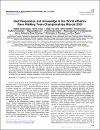Heat Preparation and Knowledge at the World Athletics Race Walking Team Championships Muscat 2022
| Author | Galan-Lopez, Natalia |
| Author | Esh, Chris J. |
| Author | Leal, Diogo Vaz |
| Author | Gandini, Silvia |
| Author | Lucas, Ronan |
| Author | Garrandes, Frederic |
| Author | Bermon, Stephane |
| Author | Adami, Paolo Emilio |
| Author | Kajeniene, Alma |
| Author | Hosokawa, Yuri |
| Author | Chrismas, Bryna Catherine Rose |
| Author | Stevens, Christopher J. |
| Author | Taylor, Lee |
| Available date | 2024-05-27T08:23:09Z |
| Publication Date | 2023-06-06 |
| Publication Name | International Journal of Sports Physiology and Performance |
| Identifier | http://dx.doi.org/10.1123/ijspp.2022-0446 |
| Citation | Galan-Lopez, N., Esh, C. J., Leal, D. V., Gandini, S., Lucas, R., Garrandes, F., ... & Taylor, L. (2023). Heat preparation and knowledge at the world athletics race walking team championships Muscat 2022. International journal of sports physiology and performance, 18(8), 813-824. |
| ISSN | 1555-0265 |
| Abstract | Purpose: To assess elite racewalkers’ preparation strategies, knowledge, and general practices for competition in the heat and their health status during the World Athletics Race Walking Teams Championships (WRW) Muscat 2022. Methods: Sixty-six elite racewalkers (male: n = 42; mean age = 25.8 y) completed an online survey prior to WRW Muscat 2022. Athletes were grouped by sex (males vs females) and climate (self-reported) they live/trained in (hot vs temperate/cold), with differences/ relationships between groups assessed. Relationships between ranking (medalist/top 10 vs nonmedalist/nontop 10) and precompetition use of heat acclimation/acclimatization (HA) were assessed. Results: All surveyed medalists (n = 4) implemented, and top 10 finishers were more likely to report using (P = .049; OR = 0.25; 95% CI, 0.06%–1%), HA before the championships. Forty-three percent of athletes did not complete specific HA training. Females (8% [males 31%]) were less likely to have measured core temperature (P = .049; OR = 0.2; 95% CI, 0.041–0.99) and more likely to not know expected conditions in Muscat (42% vs 14%; P = .016; OR = 4.3; 95% CI, 1%–14%) or what wet bulb globe temperature is (83% vs 55%; P = .024; OR = 4.1; 95% CI, 1%–14%). Conclusions: Athletes who implemented HA before the championships tended to place better than those who did not. Forty-three percent of athletes did not prepare for the expected hot conditions at the WRW Muscat 2022, primarily attributed to challenges in accessing and/or cost of equipment/facilities for HA strategies. Further efforts to bridge the gap between research and practice in this elite sport are needed, particularly in female athletes. |
| Language | en |
| Publisher | Human Kinetics Publishers Inc. |
| Subject | barriers endurance heat adaptation in-competition |
| Type | Article |
| Pagination | 813-824 |
| Issue Number | 8 |
| Volume Number | 18 |
| ESSN | 1555-0273 |
Files in this item
This item appears in the following Collection(s)
-
Physical Education [132 items ]


